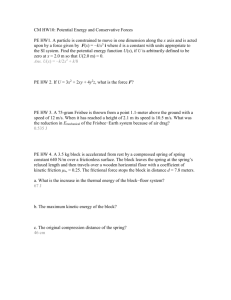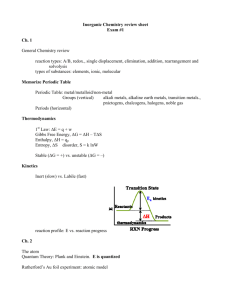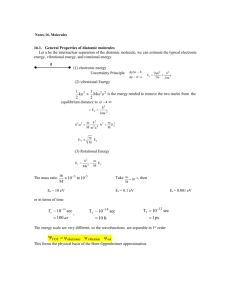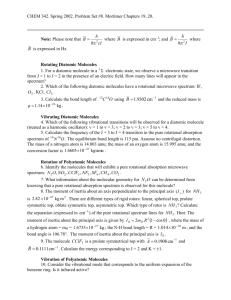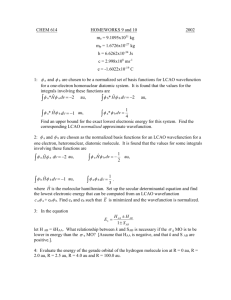CHM 3411 - Physical Chemistry II
advertisement
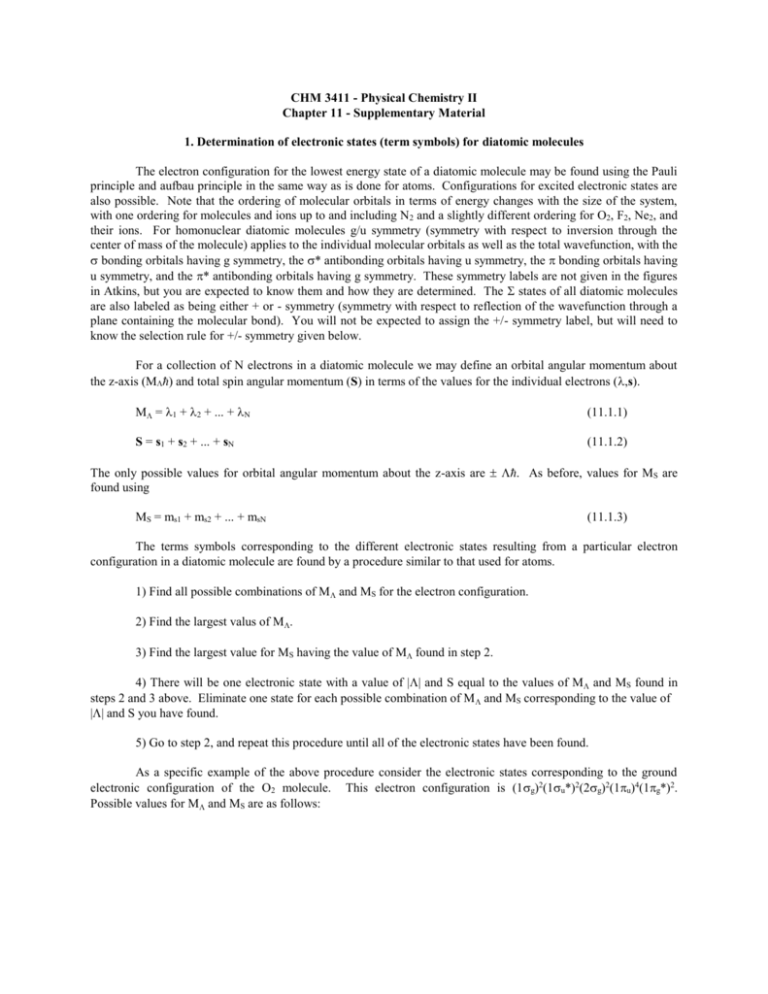
CHM 3411 - Physical Chemistry II Chapter 11 - Supplementary Material 1. Determination of electronic states (term symbols) for diatomic molecules The electron configuration for the lowest energy state of a diatomic molecule may be found using the Pauli principle and aufbau principle in the same way as is done for atoms. Configurations for excited electronic states are also possible. Note that the ordering of molecular orbitals in terms of energy changes with the size of the system, with one ordering for molecules and ions up to and including N2 and a slightly different ordering for O2, F2, Ne2, and their ions. For homonuclear diatomic molecules g/u symmetry (symmetry with respect to inversion through the center of mass of the molecule) applies to the individual molecular orbitals as well as the total wavefunction, with the bonding orbitals having g symmetry, the * antibonding orbitals having u symmetry, the bonding orbitals having u symmetry, and the * antibonding orbitals having g symmetry. These symmetry labels are not given in the figures in Atkins, but you are expected to know them and how they are determined. The states of all diatomic molecules are also labeled as being either + or - symmetry (symmetry with respect to reflection of the wavefunction through a plane containing the molecular bond). You will not be expected to assign the +/- symmetry label, but will need to know the selection rule for +/- symmetry given below. For a collection of N electrons in a diatomic molecule we may define an orbital angular momentum about the z-axis (M) and total spin angular momentum (S) in terms of the values for the individual electrons (,s). M = 1 + 2 + ... + N (11.1.1) S = s1 + s2 + ... + sN (11.1.2) The only possible values for orbital angular momentum about the z-axis are . As before, values for MS are found using MS = ms1 + ms2 + ... + msN (11.1.3) The terms symbols corresponding to the different electronic states resulting from a particular electron configuration in a diatomic molecule are found by a procedure similar to that used for atoms. 1) Find all possible combinations of M and MS for the electron configuration. 2) Find the largest valus of M. 3) Find the largest value for MS having the value of M found in step 2. 4) There will be one electronic state with a value of || and S equal to the values of M and MS found in steps 2 and 3 above. Eliminate one state for each possible combination of M and MS corresponding to the value of || and S you have found. 5) Go to step 2, and repeat this procedure until all of the electronic states have been found. As a specific example of the above procedure consider the electronic states corresponding to the ground electronic configuration of the O2 molecule. This electron configuration is (1g)2(1u*)2(2g)2(1u)4(1g*)2. Possible values for M and MS are as follows: = +1 _____ = -1 _____ M MS +2 0 0 0 0 -2 0 +1 0 0 -1 0 Based on the above table, there will be one state with || = 2 and S = 0. We eliminate two combinations from the above list for this state (+2,0) and (-2,0). There will now be a second state, with || = 0 and S = 1. We eliminate three combinations from the above list for this state (0,+1), (0,0), and (0,-1). This leaves one combination left, (0,0), which corresponds to a || = 0 and S = 0 state. || S term symbol 2 0 0 0 1 0 1 g g1 g 3 Hund's rules may be used to place these states in order of energy. In this case 3g- < 1g < 1g-. 2. Selection rules for diatomic molecular electronic spectroscopy The following selection rules apply for allowed transitions in diatomic molecules: 1) Orbital angular momentum selection rule. Note that || = 0 for a state, || = 1 for a state, || = 2 for a state, and so forth. = 0, 1 2) Spin angular momentum selection rule S = 0 3) g/u symmetry selection rule allowed forbidden gu gg ug uu 4) +/- selection rule (applies only to transitions between states). allowed forbidden ++ +- -- -+
